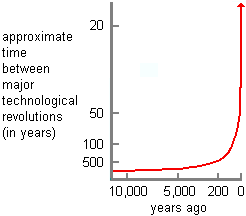Over the last 10,000 years, human populations have grown rapidly. This has resulted in increased pressure to produce more food with the same amount of land. As a consequence, our foraging ancestors were forced to change their subsistence patterns radically. Horticulture and pastoralism solved the problem for several thousand years. However, by 5,000 years ago in some regions of the world, intensive agriculture became a necessity. During the 19th and 20th centuries, most of humanity was forced to adopt this means of food production. Accompanying the transition to intensive agriculture was the development of towns, cities, and international commerce.

With each successive stage in this transition, people steadily moved away from a passive dependence on the environment. As human populations grew, more food had to be provided, which inevitably meant that there had to be greater control of food sources. Foragers and pastoralists generally use their environments without changing them significantly. In contrast, regions occupied by the early intensive farming societies were radically altered. Forests were cut down, the land was leveled, and the courses of rivers were altered to provide irrigation water. Many wild plant and animal species came to be defined as weeds or pests and were eradicated. Others were genetically altered through thousands of years of selective breeding to be more useful for people. They became the domesticated food plants and farm animals that are critical to our life today.
 |
|
|
Political elites in contemporary society |
|
Societies generally became
more complex with each successive stage in this transition from foraging to
intensive agriculture. Most foragers had small communities without permanent leaders or other full-time non-food-producing
specialists. Their political systems were more or less egalitarian
![]() . Relationships were based mainly on kinship ties and
friendship. In contrast, societies that rely on intensive agriculture to
supply their food have class stratification and elaborate political systems
with hierarchies of leaders and bureaucrats. They are no longer
societies of equals. Some individuals become rich and politically
powerful through their control of the means of production, while others face
conditions of poverty with severe periodic food shortages. This
discrepancy in access to resources has been common in large-scale
agricultural societies. However, economic inequality was significantly reduced in industrial
nations during the 20th century as a result of the evolution of more
democratic political systems and taxation that redistributed society's
wealth to some degree.
. Relationships were based mainly on kinship ties and
friendship. In contrast, societies that rely on intensive agriculture to
supply their food have class stratification and elaborate political systems
with hierarchies of leaders and bureaucrats. They are no longer
societies of equals. Some individuals become rich and politically
powerful through their control of the means of production, while others face
conditions of poverty with severe periodic food shortages. This
discrepancy in access to resources has been common in large-scale
agricultural societies. However, economic inequality was significantly reduced in industrial
nations during the 20th century as a result of the evolution of more
democratic political systems and taxation that redistributed society's
wealth to some degree.
Increased efficiency in food production has resulted in a dramatic rise in the number of non-food-producers. Among foragers, it is common for 100% of the healthy adult population to participate directly in getting food. In Bangladesh, Guatemala, and other relatively poor developing nations today, where farming has not been significantly mechanized, 60-65% of the population are food producers. In the United States, less than 1% of the entire population are still farmers. Those farmers not only provide food and fiber for all of the non-food-producing Americans but also for millions of people elsewhere in the world. It is ironic, that this dramatically increased food production has not resulted in more leisure time. Far from it, Americans now individually work more hours during the year than almost all other nations.

|

|
 |
||
|
Non-food producing specialists in a modern large-scale agricultural society |
||||
The
transition to intensive agriculture apparently had a major effect on the
spread of human parasitic diseases
![]() . The higher
population densities of people resulting from this subsistence pattern made it
far easier for contagion to rapidly pass from individual to individual.
Major epidemics
. The higher
population densities of people resulting from this subsistence pattern made it
far easier for contagion to rapidly pass from individual to individual.
Major epidemics
![]() of bubonic plague
of bubonic plague
![]() , small pox,
influenza
, small pox,
influenza
![]() ,
and other scourges are far more likely to spread rapidly in towns and cities
than among relatively isolated small communities of foragers or
horticulturalists. They are also more likely to infect a higher
percentage of the people in a dense population. It is not surprising that the global
influenza epidemic of 1918 killed 20-40 million people. The number of
deaths due to AIDS is likely to be far higher than this during the next 10-20
years. Africa will be especially hard hit by it.
,
and other scourges are far more likely to spread rapidly in towns and cities
than among relatively isolated small communities of foragers or
horticulturalists. They are also more likely to infect a higher
percentage of the people in a dense population. It is not surprising that the global
influenza epidemic of 1918 killed 20-40 million people. The number of
deaths due to AIDS is likely to be far higher than this during the next 10-20
years. Africa will be especially hard hit by it.
Our large modern cities with their vast areas of concrete and asphalt change the local microclimate by altering the amount of solar energy that is absorbed rather than reflected back out into space. Cities literally become hot spots. These artificial man-made environments also usually experience air and water pollution problems not encountered when our populations were smaller and more dispersed. In addition, our burgeoning populations progressively deplete important natural resources such as drinking water, natural gas, and oil.
Another consequence of the transition to intensive agriculture and large-scale societies has been a change in the nature of warfare. While most foraging societies were peaceful and avoided violent conflicts with other societies when possible, all of the ancient civilizations carried out bloody wars of conquest. Some pastoralist societies were aggressive conquerors as well. As agriculture became more intensive and populations larger in modern times, the scale of war increased dramatically. Far more people were killed as a result of warfare during the 20th century than in any other century in history. Armies were much larger and better equipped with efficient mass killing machines.

|
 |
|
|
Tools of mass warfare used by modern large-scale agricultural societies |
||
On the positive side, however, the 20th century also saw a rapid increase in scientific knowledge and life expectancy in the developed nations. The time between major technological revolutions has shortened to less than a single human generation. By comparison, the lives of our relatively isolated, self-sufficient forager ancestors remained largely unchanged over many generations.
 |